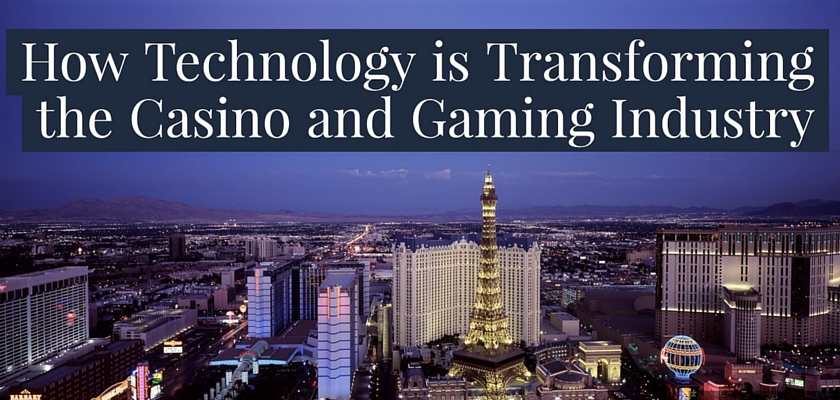Casinos use everything from facial recognition to RFID chips in their poker chips for security, and there are some technologies that casinos use in the same way as any sophisticated hotel or resort. Mobile apps for customer service and check-in enable guests to go straight to their room, thanks to NFC door locks, where they can set the temperature and lighting, order room service or book show tickets. IP phones in the room can automatically offer different services to different guests; high rollers might get a direct line to a dedicated concierge using the same quick-dial button that normally calls housekeeping. The Wynn in Las Vegas programs their key cards with multiple functions, giving guests access to their rooms and acting as a player’s card, so what they gamble is tagged straight into their account.

The monitoring isn’t just for security, or even for operations – although casinos are very efficient at that. Facial recognition spot important guests as well as known card counters. RFID in chips not only prevents theft and counterfeiting, it also means you can see exactly how much money is on the tables and what the flow of bets looks like. Instrumented slot machines report back when they need emptying or refilling with coins. Tracking systems help casinos determine how often players are winning.
What the casino industry has really pioneered is data modelling and predictive analytics, as an extreme form of CRM. It doesn’t just end with getting visitors to put the geo-fenced casino app on their phone—a tactic you can leverage to send them a text message or push notification with a special offer. It also means you can find out more about their preferences and keep track of their playing history – and send that information to nearby employees so they can offer the best customer service.
Building a model that lets casinos spot exactly which gamblers are on the verge of losing the bet would make you money, but would also mean you could lose them as a customer. When the danger is that they’ll walk away and may never come back, you want to intervene and manage the relationship in real time.
Player tracking systems record every detail about every bet – how much it’s for, what the odds are, how long the player has been at the table. Using data modelling, casinos create player profiles that help them assess the risks for each player – and manage that. Usually, you want to keep people on the gaming floor, so sending over a drink or even ‘comping’ their hotel room keeps them feeling good. But it’s also important to know when getting them away from the table for a break is the best way to keep them as a customer.
Harrah’s pioneered this approach with its Total Rewards loyalty program. Faced with other casinos spending billions to build ever-fancier spectacles to pull in the gamblers, Harrah’s managed to double the response rate on its customer offers, improve customer retention by several million dollars and increase the numbers of customers who play at more than one Harrah’s casino by 72% – by tracking and modelling those customers better.
That covers everything from the hotel reservation system (how long was their last stay and did they want a smoking or non-smoking room), to the special events customers attended (i.e. poker tournaments), to the gambling they do on slot machines and at table games, to which offers they’ve been sent and which ones they redeemed.
The data warehouse with all those details covers all 40 Harrah’s properties, so they can track customers who visit multiple locations. And it’s used by all staff – from the marketing team who send millions of custom offers a year based on customer scoring and market segmentation analysis, to the call centre agents who can see whether a caller booking a room is a gold, platinum or diamond member. With this information, staff can automatically redeem the offer for these members, and can see if a first-time visitor is a valued player in another Harrah’s location and give them a room upgrade or free tickets. It’s the pit boss who will see the customer profile for someone who’s been gambling for a long time and fits the model of a customer who’s likely to leave if they lose, and offers them a complimentary dinner in one of the casino restaurants or tickets to a show.
Harrah’s uses experimental and control groups of customers to test those different marketing strategies. If they don’t build, strengthen or reinvigorate the relationship with customers, or if the customers they’re targeting with a strategy turn not to have the value to the businesses that the model predicted, that goes back into the data model.
Although the glitz isn’t going away, more casinos have been adopting this kind of customer data mining and modelling. They can take the kind of analytics normally restricted to websites and apply it to visitors in the real world, and dramatically improve business.
To learn more about how cloud technology is transforming the casino and gaming industry, visit our cloud for casino and gaming page, or request information.
 Mary Branscombe is a freelance technology journalist for a wide range of sites. She has been a technology writer for more than two decades, covering everything from early versions of Windows and Office to the first smartphones, the arrival of the Web, and most things in between, from consumer and small business technology, to enterprise architecture and cloud services. She also dabbles in mystery fiction about the world of technology and startups. Visit www.marybranscombe.com or follow @marypcbuk on Twitter.
Mary Branscombe is a freelance technology journalist for a wide range of sites. She has been a technology writer for more than two decades, covering everything from early versions of Windows and Office to the first smartphones, the arrival of the Web, and most things in between, from consumer and small business technology, to enterprise architecture and cloud services. She also dabbles in mystery fiction about the world of technology and startups. Visit www.marybranscombe.com or follow @marypcbuk on Twitter.


